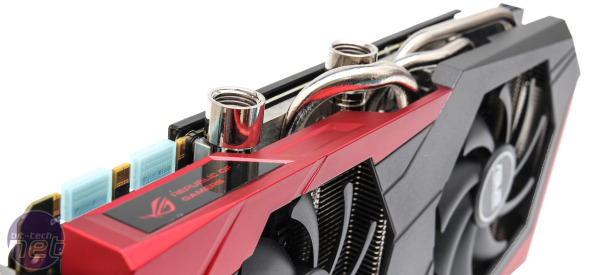Cooling Performance and Overclocking
As the GeForce GTX 780 3GB as a GPU isn't exactly new and the main focus of the Poseidon is with noise reduction and cooling, we've run a separate Unigine Valley test to show the difference the extra cooling and overclocking made in a similar way to our recent R9 290X water cooling article. There is a modicum of thermal throttling after all with both the GTX 780 3GB and GTX 780 Ti 3GB, although nowhere near as much as the AMD card.Click to enlarge
To start with we opened up Asus' GPU Tweak overclocking program and de-restricted the power options giving full control to the GPU clocks, voltage, power target and GPU temperature target. There's not a huge deal of overclocking headroom with the GTX 780 3GB to start with, but with the GPU core having been tweaked by Asus and having risen from 836MHz to 954MHz already, we weren't expecting massive gains, even with water cooling.
Under the power of its twin 90mm fans, we eventually settled on a GPU clock of 1,109MHz and a Boost clock of 1,161MHz having raised the Power Target to 110 per cent and GPU Temp Target to 95°C. Sadly, maxing out the GPU voltage didn't allow us to get any further, and the voltage adjustment didn't seem to do anything for overclocking in general - it was stable here whatever the voltage but refused to go any higher without graphics glitches and artifacts rearing their heads.
This was the same even if we then maxed out the GPU voltage. Even so, this is a massive 33 percent overclock above the stock GTX 780 3GB GPU clock speed - not exactly something to be sniffed at. We saw a healthy boost in memory frequency too, eventually settling on 1,668Mhz (6.67GHz effective), although this is some way off what we managed with our reference card but hey, that's the luck of the draw with these things.
This was enough for some pretty significant gains, though, with the biggest gains seen in Battlefield 4 with the minimum frame rate rising from 31fps to 35fps - 6fps higher than the reference card and just under 19 per cent faster. There was a 12 per cent leap in performance over the out-of-the-box frequencies in Unigene Valley with the air-cooled score for example rising from 2,679 to 3,013.
Above you can see air-cooled results in red, water-cooled results in dark blue and a reference GTX 780 3GB in light blue. As you can see there's very little difference in terms of scores in Unigine Valley between air and water-cooled numbers. We ran the built-in benchmark twice to let the card come up to temperature first and took the second result for the score.
Click to enlarge
It's unlikely the card will get warm enough in your average game benchmark lasting just a few minutes for any thermal throttling to get involved but it's plain to see that as far as air and hybrid modes are concerned, you're certainly not gaining anything here by water-cooling the card. A shame? Not really - it's just the difference between AMD's and Nvidia's high-end offerings at the moment but head over the page to read our cooling and noise analysis.

MSI MPG Velox 100R Chassis Review
October 14 2021 | 15:04











Want to comment? Please log in.